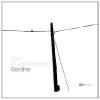Texte paru dans: / Appeared in:

Fanfare Magazine: 35:2 (11-12/2011)
Pour
s'abonner / Subscription information
Les abonnés à Fanfare Magazine ont accès aux archives du
magazine sur internet.
Subscribers to Fanfare Magazine have access to the archives of the magazine
on the net.
Soli Deo Gloria
SDG712

Code-barres / Barcode:
0843183071227
Consultez toutes les évaluations recensées pour ce cd
~~~~ Reach all the evaluations located for this CD
This is tricky. That’s what happens when your longtime benchmark version of a work is rerecorded by the same artist. Why did he (or she) do it? And is the new version better than—or as good as—the original? In the case of John Eliot Gardiner’s new Saint John Passion, the first question is easily answered because Gardiner has explained it in his program note. As he worked through his epic Bach Cantata Pilgrimage, Gardiner came to the conclusion that the Saint John Passion was not an independent, freestanding work, but rather the logical and spiritual culmination of Bach’s first cantata cycle—that the cantatas of 1723 and early 1724 were, in effect, a cumulative prelude to thePassion. Consequently, for Gardiner himself the final concert in New York did not close the door on the Pilgrimage; he had to perform the Saint John Passion. Three years later, on March 22, 2003, he broadcast this live performance from the Kaiserdom in Königslutter, Germany.
How does the new version differ from the original? For starters, it was not recorded in a studio but instead from a live broadcast performance. Fortunately, the usual hazards of live recording are not much of an issue here, and, even better, there is no applause at the end of the performance. Both the Monteverdi Choir and the English Baroque Soloists have undergone modest diets. The choir now numbers 6-4-4-4, down from 7-6-5-5, and the strings are down one first violin to 5-4-3-3-1. SDG’s roster lists one organist, not two, and does not mention specialists for the viola d’amore, viola da gamba, oboes d’amore, or oboes da caccia. A female alto soloist, Bernarda Fink, has replaced countertenor Michael Chance. SDG’s disc break comes at the end of part 1, not at the halfway point.
Gardiner’s conception of the Saint John has evolved, not drastically, but in subtle ways. The new performance, like its predecessor, is expressly dramatic, deeply moving, and superbly sung and played. Despite a nearly universal turnover in personnel, the choir and the orchestra remain what they were: an ideal extension of Gardiner’s vision. (Just one veteran of the 1986 session also participated in the 2003 broadcast: double bassist Valerie Botwright.) Both rosters of soloists are excellent. Comparisons between them are not particularly useful and are likely to be governed by personal preferences. I happen to prefer Fink to Chance, but that is no way a judgment on Chance. Mark Padmore is a compelling Evangelist, but so was Anthony Rolfe Johnson. Hanno Müller-Brachmann’s portrayal of Jesus is a model of strength and dignity; the same could be said of Stephen Varcoe’s. Gardiner’s readings of the great choruses may provide a better window into his evolution. The raw energy of the earlier version of Herr, unser Herrscher has been refined, its edges slightly rounded, though the intensity remains. Raw energy has not gone away; it’s abundantly evident in the electrifying crowd scenes. But not so in Ruht wohl. Gardiner has never been in thrall to orthodoxy, but in the new Ruht wohl he is more freely expressive and profoundly eloquent than ever. It’s not an easy choice, but I think I have a new benchmark.
Fermer la fenêtre/Close window
Cliquez l'un ou l'autre
bouton pour découvrir bien d'autres critiques de CD
Click either button for many other reviews


